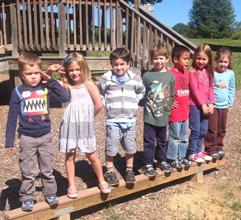Kindergarten




Esther Shartar-Howe
Kindergarten Teacher
SBS Class of 1997
Hampshire College, BA
UVEI, NH Elem. Ed. Cert.
The kindergarten classroom is designed to help students progress from more physical, body-centered ways of learning to more conceptual, symbolic ways. Play is an important part of our curriculum. It helps children develop complex ideas, flexibility in thinking, and an understanding of different points of view. As the year progresses, our studies are shaped by the questions and interests of students.
We start each day with a morning meeting. We sit in a circle, greet each other, do our calendar and attendance routines, read our morning message, share the surprise box, and take part in a fun activity or two. This helps to build community and launch the day’s academics.
We are a community of learners. Students work both independently and cooperatively in pairs and groups. Our program takes a developmental approach that appreciates multiple learning styles. We understand that each child grows and learns at his or her own pace. Assessment will be observational, ongoing and individualized to ensure that each child is making progress in all areas of the curriculum.
Language Arts are integrated throughout the curriculum. They include oral language as well as reading and writing. The children are surrounded by print and quality literature, including books, poems, chants, fingerplays and language charts. Many activities are open ended to accommodate varying skill levels.
In our writing process, children develop their ideas through play and by acting out familiar and original stories. Students illustrate their stories and dictate them to an adult or write them down using invented spelling. Students also communicate through journal writing using words and pictures to share observations and personal experiences.
We use a variety of curriculum in Language Arts: Handwriting Without Tears teaches students to form letters correctly to help them write proficiently; Guided Reading Phonics introduces and gives students practice with beginning reading and writing skills; Sounds in Motion is a phonemic awareness and early literacy program that pairs kinetic gross motor movements with phonemes to teach sound/symbol association and articulation, and helps students develop receptive and expressive language skills and become active listeners.
In Math, we use the Investigations in Number, Data and Space curriculum, which takes a hands-on, developmental approach that encourages exploration, questioning, and sharing of thinking and strategies. Students use a variety of materials to help them in their problem solving. They practice and solidify skills through games. Topics we study include: patterns, geometry, counting and comparing, measuring, collecting data, sorting and classifying, number sense, and beginning addition and subtraction. We also use literature to highlight math topics.
In Science, students explore and discover the world around them. We spend a good deal of time outside collecting samples and taking a closer look at nature. Students practice asking questions, making hypotheses and observations, researching and expanding their sense of wonder in many different areas of interest. Topics we explore include: changes, seasons, and the trees, plants and animals of our local ecosystem.
In Social Studies, the focus is on the children and their families and communities. We learn about each other and what makes each of us unique and similar. Children are encouraged to share special family traditions. The class develops its own set of rules to make sure the environment is a place where everyone feels safe learning and taking risks. We work on problem solving, conflict resolution, community building, and developing social skills.
In Spanish class, the goal is to create situations where the vocabulary is contextualized. As students are exposed to the language, they move from being able to recognize a word and to react to it, to being able to use it in a given situation. The main tool to contextualize language is through stories created in class using a lot of visual support. Songs and games also play an important role. This is an introductory class with focus on: greetings, colors, numbers (0-20), body parts, common objects at school and at home, animals and family vocabulary.
In Art class the children spend a lot of time exploring color, shape, form and line. The focus is on the process of making art rather than creating a specific product at the end of class. We concentrate on using materials such as beeswax crayons, oil pastels, modeling beeswax, and watercolor paint; working with simple materials allows the children to make discoveries about the ways different colors and shapes are formed. Children are encouraged to explore making artwork about the natural world and the seasonal changes they see around them, as well as imagery from their own imaginations. Using modeling beeswax, kindergarten students learn to make simple forms inspired by traditional fairytales and seasonal stories.
In Music class, we integrate several elements to develop musicianship and social growth, and build on what children do naturally: sing and play. Class includes group singing, movement games and stories, rhythmic speech and movement, work with un-pitched percussion instruments, and dramatic play.
In Health Education class, the main topics are community helpers, the five senses, nutrition, safety, family life, physical activity, and the importance of handwashing. We also focus on social and emotional health; students learn ways to be friends and kind to one another and strategies for dealing with different emotions. The Health Education program has been developed in accordance with guidelines of the State of New Hampshire Health Education Standards and the National Health Education Standards.
During our STEAMS blocks, students will have the opportunity to rotate to various centers and engage in activities such as technology, writing, math, science, cooking, building, art, drama, and listening. There will be time at the end of each class for reflection on these activities and sharing what was learned.
